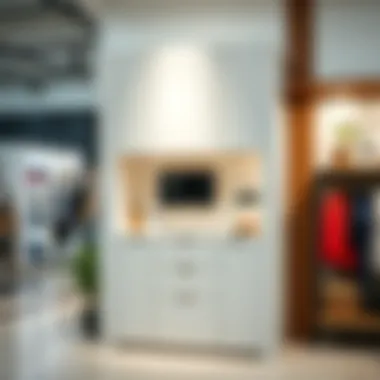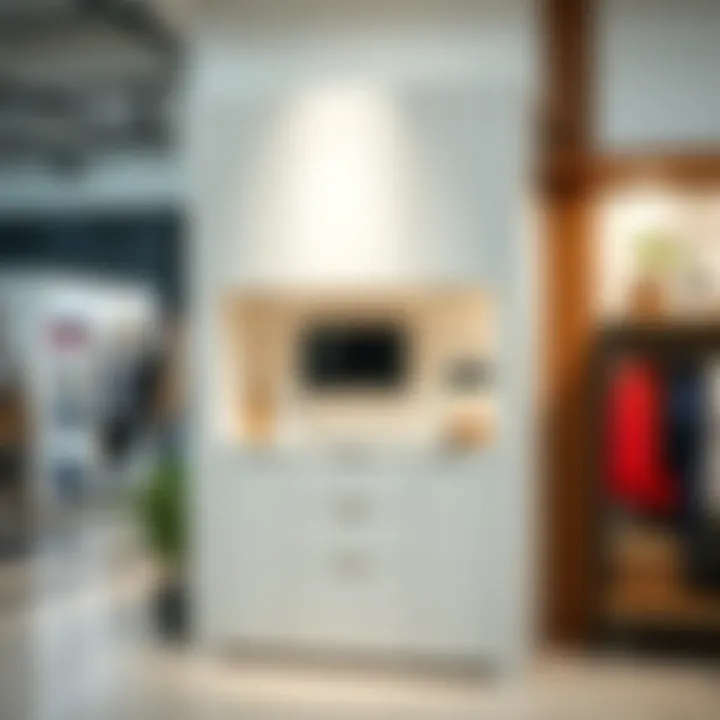The Ultimate Guide to Retail Storage Cabinets


Intro
In the bustling world of retail, the organization and presentation of goods can make or break a sales strategy. Having an efficient storage solution is not just about placing items neatly; it’s about enhancing the overall shopping experience. Retail storage cabinets play a pivotal role in this equation, allowing retailers to showcase products effectively while maintaining a clutter-free environment. This guide delves into the multifaceted world of retail storage cabinets, unpacking their functionality, design variations, and how they can elevate both business efficiency and customer experience.
The significance of a well-designed storage cabinet cannot be overstated. These cabinets do much more than hold inventory; they communicate the brand's image and contribute to an inviting shopping atmosphere. Furthermore, amidst evolving market demands, understanding current trends and customer expectations becomes crucial for any retailer. Let’s embark on a journey to discovery the latest in storage solutions and how they can foster growth and innovation in the retail space.
Understanding Retail Storage Cabinets
In any retail environment, a good storage cabinet isn’t just a piece of furniture; it’s a cornerstone of efficiency and organization. Understanding retail storage cabinets means grasping their potential to streamline operations and enhance the customer experience. From small local shops to expansive department stores, these cabinets play vital roles that often go unnoticed. They not only help in keeping the retail space tidy but also ensure that products are displayed effectively and are readily accessible.
Definition and Purpose
Retail storage cabinets are specialized furniture designed for the purpose of holding, organizing, and displaying products in a retail context. They come in a variety of shapes and sizes depending on the type of merchandise and the space they occupy. Notably, their purpose extends beyond mere storage; they help create an aesthetic environment that invites customers in and encourages them to explore.
The purpose of these cabinets can be distilled into several key points:
- Organization: They help retailers categorize merchandise for easy access. Whether it’s clothing, tools, or health products, items can be stored by category.
- Security: Many cabinets offer locking mechanisms, ensuring valuable items are safeguarded against theft.
- Display: Retail storage cabinets are smartly designed to allow products to shine. Stylish display cabinets can entice customers, drawing their attention to featured items.
- Space Management: Efficient use of space is crucial in retail settings. These cabinets maximize vertical and horizontal space, making even the smallest shops feel more organized.
Different Types of Storage Cabinets
When it comes to types of retail storage cabinets, the options are nearly endless. What suits one retailer may not fit another, and understanding the distinct categories can guide an informed choice:
- Display Cabinets: Usually made of glass or acrylic, these cabinets allow customers to view items from all angles. Perfect for containing jewelry or collectibles.
- Shelving Units: Often adjustable, these are versatile and can be used for various products, from books to kitchenware. They’re a staple in many stores.
- Lockable Cabinets: Designed for security, these cabinets are essential for storing high-value items, making theft more difficult.
- Multi-functional Cabinets: Some cabinets blend storage with display, providing both organization and visibility. These are commonly seen with lifestyle merchandise like gadgets or home décor.
- Mobile Cabinets: For retailers needing flexibility, mobile cabinets can be wheeled around, allowing quick reorganization of the display space based on customer traffic.
Each type of cabinet serves a specific purpose, and understanding these nuances can empower retailers to make strategic choices that reflect their brand and operational needs. The right storage solutions can effectively shape the retail journey, aiding in functional and aesthetic achievements while promoting an inviting environment for customers.
Functional Benefits of Retail Storage Cabinets
The utility of retail storage cabinets often goes unnoticed in the grand scheme of retail environments. Nonetheless, these cabinets serve crucial functions that can significantly enhance business operations. In a bustling retail setting, creating an organized space that promotes efficiency and ease of access can turn a chaotic atmosphere into one of fluidity and order. This section will explore two major benefits of retail storage cabinets: enhancing space utilization and improving organization and accessibility.
Enhancing Space Utilization
Every square foot of retail space comes at a price. Whether you're in a quaint boutique or a sprawling department store, maximizing your floor area is essential for profitability. Retail storage cabinets are not just vessels for holding products; they can be strategic tools in your business arsenal.
One smart way to utilize these cabinets is by selecting vertically designed units. These cabinets are often narrow but tall, fitting snugly into corners and allowing you to reach for those upper shelves without needing a step stool. Instead of spreading items out over a large area, tall cabinets help concentrate your inventory, unlocking lost floor space for customer movement and product display.
Additionally, incorporating modular storage systems lets you customize the layout as per changing needs. By being able to rearrange or stack storage, you can swiftly adapt to seasonal fluctuations in stock or promotional activities without significant overhauls. When you design your layout with the flexibility of modular cabinets in mind, it's almost like having your cake and eating it too.
"The secret to great retail is not just about what you sell, but how you showcase it."
Moreover, cabinets that feature multi-purpose designs are an excellent investment. For instance, utilizing storage cabinets with attached display shelving effectively combines storage and visibility. This ensures that products are not only stored but also showcased to potential customers, drawing attention without cluttering the sales floor. Such creativity in space utilization can lead to increased impulse purchases, benefiting overall sales.
Improving Organization and Accessibility
The effectiveness of a retail business lies heavily in how well it organizes its inventory. Retail storage cabinets play a pivotal role in streamlining this aspect. Think of cabinets as the backbone of your stock management. A disorganized stockroom can quickly spiral into a feline frenzy of frustration for employees searching for items.
When all products are categorized and stored in dedicated shelving, it becomes far easier for staff to locate items swiftly. This translates to improved customer service since staff can attend to queries faster and with confidence. Having a system where every item has a designated home not only enhances workflow for employees but builds a structured environment that resonates with customers, creating a more enjoyable shopping experience.
In addition, the accessibility of products is simplified with retail storage cabinets that are easy to open and close, ensuring that employees can swiftly restock shelves or retrieve goods for customers. Options like cabinets with glass doors or open shelving also enable quick visibility into stock levels without the need to rummage through closed doors.
Furthermore, organizing items with clear labels or color-coding systems enhances visual accessibility. This is especially crucial during peak hours when time is of the essence. A well-thought-out organization system introduces a calming effect on the staff; it feels like moving through a well-oiled machine rather than a frenzied scuffle.
In sum, retail storage cabinets are not merely functional constructs; they are vital components that help optimize retail space and improve operational workflows. The profound impact these cabinets have on space utilization and organizational efficiency cannot be overstated. As retail continues to evolve, innovative and strategic placement of storage solutions will set successful retailers apart from their peers.
Design Considerations
When diving into the realm of retail storage cabinets, design considerations emerge as a key element that can make or break effective usage. Design is not merely about aesthetics; it encompasses functionality, ergonomics, and the ability to mesh with the overall atmosphere of your retail space. A well-thought-out design can profoundly enhance both the efficiency of operations and the satisfaction of customers.
Style and Aesthetic Integration
The style and aesthetic integration of storage cabinets play a pivotal role in how a retail space is perceived. A cabinet that blends harmoniously with the store's overall design can elevate the shopping experience. Consider this: a sleek, modern cabinet crafted from tempered glass can resonate well in an upscale boutique, while a rustic wooden cabinet might be a perfect fit for a quaint, artisanal shop. Here are some points to ponder:
- Brand Identity: The choice of cabinet should align with your brand's identity. A bold color can express vibrancy, whereas neutral tones can convey sophistication.
- Materials and Finishes: The texture of materials also makes a significant impact. A mix of wood and metal can demonstrate durability while still being stylish.
- Lighting: Integrating appropriate lighting can accentuate storage units, making them more than just functional – they become part of the visual narrative.
A cohesive design approach not only catches a customer’s eye but also fosters an environment that customers wish to return to. It’s about creating a welcoming mood that encourages browsing and, ultimately, purchasing.
Size and Configuration
The size and configuration of storage cabinets are equally vital. It's about optimizing every inch to ensure both accessibility and beauty. A cabinet that is too large may overwhelm a space, while one that is too small can lead to cluttered displays and ineffective organization. Here are key aspects to consider:


- Space Available: Prior to purchasing, measure your retail area meticulously. Know where the shelving will go and how products will flow around them.
- Adjustable Configurations: Choosing cabinets that allow for flexibility in height and shelf placements can cater to different product types and sizes, ensuring versatility for changing inventory.
- Multi-Functional Designs: Incorporate cabinets that provide both storage and display functionalities. A combination of open shelves and enclosed spaces can showcase products while keeping some items tucked away safely.
In summary, design considerations in retail storage cabinets can deeply affect customer interactions and the overall workflow of a store. When style meets practicality, businesses can transform their retail space into an engaging, efficient environment that feels crafted rather than cluttered.
"The devils in the details; ensuring both form and function can lead to retail success."
For more insight on improving retail spaces, consider checking out additional resources such as Retail Dive and Shopify's Retail Blog.
Material Choices for Storage Cabinets
When it comes to selecting storage cabinets in a retail setting, the materials used are of paramount importance. The choice of materials not only affects the durability and aesthetic appeal of the cabinets but also influences functionality, maintenance, and environmental impact. Selecting the right material can make a big difference in how a retail space is organized and how effective it becomes in serving both the retailer and the customers.
Wood vs. Metal vs. Plastic
When weighing the options, wood, metal, and plastic each have their own distinct characteristics and advantages.
- Wood: Wooden cabinets evoke warmth and a sense of craftsmanship, making them an appealing choice for businesses that want to convey a premium image. They are versatile and can be finished in numerous ways to match a store's décor. However, wood requires more upkeep to protect it from scratches and water damage. Retailers need to be mindful of sourcing sustainably to avoid contributing to deforestation.
- Metal: Metal storage cabinets are synonymous with durability and security. They can withstand heavy loads and resist wear and tear remarkably well, making them ideal for stockrooms or areas where the cabinets may be exposed to high use. On the flip side, while they may not provide the warmth of wood, they can have a sleek, modern look that works for many contemporary retail environments. Not to mention, they can be more difficult to customize aesthetically.
- Plastic: Plastic cabinets present a strong argument when it comes to affordability and weight. They are lightweight, easy to move, and often resistant to moisture, which makes them suitable for various retail environments. However, they may not hold up well under significant stress compared to wood or metal. Additionally, they might not provide the same level of visual appeal for higher-end retail spaces.
Selecting the right material should be based on the specific needs and character of the retail space. As a retailer, it's best to consider both the aesthetic and pragmatic implications.
Sustainability and Eco-Friendliness
In a world where environmental consciousness is on the rise, the sustainability of materials cannot be overlooked. Retailers increasingly prioritize eco-friendly options when selecting storage cabinets.
Wood can be a sustainable choice if sourced from certified forests. This ensures that the materials used are renewable and contribute positively to the environment. Additionally, there are composite materials available, which can include recycled wood, providing a sturdy alternative that decreases environmental burden.
On the other hand, metals can also be recycled, greatly reducing their carbon footprint if they ever need to be disposed of. Many manufacturers are exploring ways to use recycled metals, which can also be a selling point to eco-minded consumers.
Plastics, while often criticized for their environmental impact, are also evolving. Many of the new plastic storage options are made from recyclable materials. Retail customers are becoming increasingly aware of these options and may choose brands that align with their values.
"The materials you choose for storage solutions can reflect your brand's values and commitment to sustainability, resonating with consumers who prioritize eco-friendliness."
Retail Trends Influencing Storage Solutions
Understanding current retail trends is crucial for optimizing storage solutions in any business. As retailers adapt to changing consumer behaviors and technological advancements, the influence on storage systems is noteworthy. Let's break down two key aspects that are shaping the future of retail storage cabinets: the adoption of modular systems and smart storage technologies.
Adoption of Modular Systems
Modular systems in retail storage have made waves, and for a good reason. These designs offer flexibility and adaptability, enabling businesses to easily modify their layout to fit evolving needs. From furniture stores to boutiques, modular cabinets allow space to be edited and expanded effortlessly.
- Scalability: As your inventory changes, modular systems can grow with you. This means fewer constraints compared to traditional fixed storage units.
- Customizability: Every business is unique, and modular systems cater to that. Retailers can mix and match components to create a solution that suits their exact needs.
- Space Efficiency: These systems can maximize every nook and cranny, ensuring no valuable space goes to waste.
"In our store, modular cabinets have allowed us to switch things up for seasonal displays without heavy lifting. The convenience can’t be overstated!" – A Retail Business Owner
Embracing modular storage can lead to a streamlined retail experience, transforming the mundane task of organizing into an art form.
Smart Storage Technologies
As we stride into an era dominated by technology, smart storage solutions are becoming increasingly relevant. By integrating IoT devices and automated systems, retailers are not just storing goods; they’re managing their inventory like never before.
- Inventory Management: Smart cabinets equipped with sensors can notify managers when supplies are low or if items aren't being sold. This lets you know at a glance what’s working and what isn’t.
- Space Monitoring: Using cloud-based systems, stores can monitor which shelves are being accessed frequently, allowing for enhanced display strategies.
- Data Analytics: With these technologies, retailers can analyze customer interactions with storage systems, tailoring decisions based on actual behavioral data rather than just guessing.
Incorporating smart storage technologies not only enhances operational efficiency but significantly improves customer experiences by ensuring popular items are always readily available.
Selecting the Right Storage Cabinets
When it comes to streamlining operations in a retail environment, selecting the right storage cabinets can be a game-changer. The choices you make can profoundly affect not just how products are stored, but also how efficiently your space operates. A well-chosen cabinet allows for better organization, saving you time and hassle when retrieving items. The importance of making the right choice boils down to a few essential elements.
Space Optimization: The right size and layout of storage cabinets contribute to maximizing available space. A compact but efficient design can prevent clutter, making every square inch count. Imagine a cluttered backroom where things are strewn about and chaos reigns; an effective cabinet can rectify that with shelves that can fit your specific items and keep them neatly arranged.
Functionality: Cabinets aren’t just for storage; they can serve multiple purposes. You could use adjustable shelving for diverse item sizes or include integrated lighting. This multifunctionality can enhance productivity and make tasks feel less daunting. Consider a scenario where a retailer has space for stock but struggles with access. Appropriate cabinets could enhance accessibility, reducing precious time spent searching for products.
Security Features: Depending on what’s stored inside, security becomes a significant factor. Locked cabinets can prevent unauthorized access to valuable items, whether it’s high-end merchandise or sensitive documents. Understand your inventory’s risks and ensure that your cabinets can offer the protection required.
"Selecting the right storage cabinet can streamline your retail operations and improve the aesthetic of your space."
Ensuring that you choose the right type may require a closer look at the next points.
Assessing Needs and Inventory


Identifying your specific needs is paramount when selecting storage cabinets. Think about the types of items you will be storing. Are they seasonal products that need quick access or perhaps fragile items that require extra care? Your inventory dictates how you should approach your cabinet selection.
- Analyze Inventory Size: Understanding the amount of stock you have is essential. Larger inventories demand bigger and more robust storage solutions. Keep in mind that as you grow, your storage needs may change too.
- Weight Considerations: Heavy-duty items require sturdy cabinets. Check weight ratings to guarantee that the selected cabinets can handle your goods. Having cabinets break down under pressure is not only inconvenient but can cause damage to products.
- Accessibility Needs: Think about who will be using these cabinets. Will staff or customers need access? Adjust your decisions based on who needs to reach what items.
Budgeting and Cost Considerations
Once you've identified the essential attributes for your storage cabinets, it’s time to factor in budgeting. The cost can significantly vary, and being smart about expenses can save you money in the long run. Here’s what to ponder:
- Initial Costs vs. Long-Term Savings: Investing in higher-quality cabinets might require more upfront cash, yet they often pay off through durability. Cheaper alternatives may fall apart faster or need replacements sooner.
- Installation Expenses: Remember that installation isn’t always included. You might need to factor in any professional services if you aren’t going the DIY route. Don’t shy away from asking contractors for quotes.
- Operational Costs: Some cabinets may come with features that save time or prevent damage. While they could cost more initially, the efficiency gains may lower labor costs and operational hassles over time.
Closure
Choosing the right storage cabinets is a crucial part of effective retail management. By considering your needs, analyzing your inventory, and being mindful of costs, you can find the perfect storage solutions that enhance your operational efficiency.
Installation and Maintenance
Ensuring the correct installation and ongoing maintenance of retail storage cabinets holds the key to harnessing their full potential. A well-installed cabinet meets both aesthetic and functional needs while serving the demands of daily use. The longevity and performance of storage solutions significantly hinge on these two aspects.
Improper installation can lead to structural issues, rendering a cabinet not only unsightly but potentially unsafe. Additionally, an effective maintenance routine helps preserve the condition of storage units over time, which in turn enhances customer experience in a retail environment. Attending to both installation and maintenance ensures that the cabinets remain a reliable asset in the business arsenal.
Proper Installation Techniques
Getting installation right is not a matter of guesswork; it’s an art that blends skill and precision. Here are some foundational steps to follow for installation:
- Preparing the Area: The first step involves clearing out the space where the cabinet will stand, ensuring there’s enough room to maneuver. Measure your area—this lets you determine the right position for optimal accessibility and visibility.
- Reading Manufacturer Instructions: Every cabinet comes with a unique set of assembly instructions. Always start by thoroughly reading these before you make any cuts or adjustments. Skipping this can lead to mistakes that could be costly.
- Utilizing the Right Tools: Equip yourself with essential tools—screwdrivers, levels, and possibly a drill. A level is critical for ensuring your cabinet stands straight. When you're stacking units, take extra time to align them.
- Anchoring: If your cabinets are tall or heavy, consider securing them to the wall. This simple precaution prevents tipping hazards, especially in stores where high foot traffic occurs.
- Final Adjustments: Once installed, do a final walk-through. Check for any loose screws and ensure that the doors open smoothly. If needed, make any last-minute tweaks to ensure that everything sits just right.
Ongoing Care and Maintenance Tips
After installation, the focus shifts to keeping your cabinets in good nick. Regular maintenance enhances durability and appearance:
- Routine Cleaning: Dust and grime can accumulate quickly. A microfiber cloth with a gentle cleaner usually does the trick. Avoid harsh chemicals that could dull the finish.
- Inspect Regularly: Take a few moments each month to check hinges, handles, and any fittings. If you notice anything loose, tighten it before it becomes a bigger issue.
- Avoid Overloading: While storage cabinets are sturdy, they're not invincible. Familiarize yourself with load limits to prevent bending or breaking.
- Address Damage Promptly: If an item gets scratched or a panel is chipped, address it now rather than later. A touch of paint or a wood filler can prevent the damage from worsening.
- Seasonal Checks: Change of seasons can impact materials, especially wood. Ensure that your cabinets aren’t exposed to moisture, which can lead to warping.
"A stitch in time saves nine." A little proactive maintenance goes a long way in preserving the integrity of your storage cabinets.
Maximizing the Customer Experience
In the realm of retail, how customers feel while navigating a store can make all the difference between a casual visit and a repeat customer. Maximizing the customer experience is not just a buzzword; it's a critical aspect that involves aligning store layouts, product accessibility, and aesthetics with customer expectations. When cabinets are designed and organized intelligently, retailers can significantly enhance shopper satisfaction, which has a direct impact on sales.
Impact on Retail Workflow
Understanding how storage solutions affect workflow can reshape a retailer's approach towards inventory management. Efficiently designed storage cabinets streamline back-end operations, making it easier for employees to access stock, thus minimizing the time taken to restock shelves or locate items. For instance, using transparent storage bins allows employees to quickly identify stock levels and locate products without rummaging through items. This isn’t just about speed; it's about enhancing productivity and reducing errors.
Moreover, an effective storage system means less clutter. Customers, in turn, enjoy a more organized shopping experience, leading to longer dwell times and potentially higher spending. For stores that rely on visual merchandising, strategically placed cabinets can draw attention to featured products without creating obstacles in the flow of foot traffic. Proper organization promotes a natural flow that guides customers through the store, facilitating an engaging and pleasant shopping experience.
Creating a Welcoming Environment
When it comes to creating a welcoming atmosphere, storage cabinet design plays a crucial role. The right choices can turn an ordinary retail space into a delightful shopping haven. Imagine entering a boutique that has warm wooden cabinets, softly integrated into the decor. The inviting aesthetics not only make customers feel more comfortable but can also influence their perception of the brand.
To foster a welcoming environment, it’s vital to consider color schematics, soft lighting, and textures that resonate with the target audience. Display cabinets that are both functional and elegantly designed can serve dual purposes: holding merchandise while enhancing the overall ambiance.
Moreover, consider using open shelving in accessible areas. This not only displays products attractively but also makes the shopping experience more interactive. Shoppers can easily reach for items, feeling a sense of autonomy as they browse through choices.
Efficient storage solutions directly correlate with customer satisfaction and can lead to higher sales.
In summary, maximizing the customer experience through thoughtful storage cabinet integration is essential in retail. It reinforces workflow efficiency and creates an inviting atmosphere, both of which are pivotal in establishing a loyal customer base. By putting careful thought into these elements, retailers can significantly elevate the shopping journey, cultivating an environment where customers feel valued and inspired to return.
Innovative Storage Solutions
In today’s fast-paced retail environment, innovative storage solutions play a pivotal role in enhancing business efficiency and customer satisfaction. With the right storage strategies, retailers can not only maximize space but also create an engaging shopping experience. Savvy retailers, designers, and even DIY enthusiasts can benefit from exploring how innovative storage cabinets can transform spaces. These solutions are tailored to meet diverse needs, combining functionality with inventive design.
Customizable Options
When it comes to retail storage, the ability to customize is invaluable. Customizable options allow retailers to adapt their storage to specific products, floor plans, and customer behaviors. For instance, a clothing retailer might prefer storage solutions that are adjustable to accommodate seasonal collections or varying merchandise. The benefits include:
- Tailored to Specific Needs: Retailers have the liberty to create solutions that cater to their unique inventory and environment.
- Adapting to Change: As consumer preferences shift, so can the layout and function of the storage, allowing for flexibility over time.
- Enhancing Customer Interaction: Custom designs can encourage customer engagement, providing displays that not only store but also showcase products effectively.
Considering the example of a furniture store, having modular cabinets that can be reconfigured allows easy display updates and restructuring according to trends, and new arrivals.
"The right storage solution can be as valuable as the products themselves, as it defines the customer journey through the retail space."


Combining Storage with Display
Merging storage with product display is an emerging trend that enhances visibility and promotes sales. This method integrates the functional aspect of storage with aesthetic appeal, allowing for a seamless customer experience. Here are some considerations when looking at this trend:
- Functionality Meets Aesthetics: Storage cabinets that double as display units help eliminate clutter and create a visually appealing environment. For example, a beauty store might use clear acrylic cabinets that showcase products while also serving as storage for backstock.
- Promoting Cross-Selling: When storage solutions are thoughtfully designed, they can encourage shoppers to explore related products. A strong example is the use of shelving units strategically placed to highlight complementary items.
- Optimizing Space: Retailers can use vertical space efficiently with innovative designs. Taller cabinets can offer ample storage while still allowing visibility, preventing any dead zones in the retail area.
By focusing on combining storage and display, retailers are not only enhancing their operational efficiency but also fostering an appealing shopping experience that resonates with customers.
Case Studies
Importance of Case Studies in Retail Storage Solutions
Case studies serve as a profound tool for understanding the impact of retail storage cabinets in various settings. By analyzing real-world examples, we can gain insights into how different retailers have approached their storage challenges and the innovative solutions they’ve implemented. This exploration is vital as it showcases not just theoretical benefits of storage systems but also practical, actionable strategies that can enhance organizational efficacy and customer satisfaction.
In examining these success stories, retailers can identify trends, pitfalls, and opportunities for their own storage needs. This targeted approach offers a blueprint that is both relatable and applicable. Case studies also highlight the diversity in retail environments; what works for a boutique might not fit a large supermarket, but there are often underlying principles that can translate across different contexts.
Success Stories from Retailers
Many retailers have transformed their spaces with effective storage solutions, highlighting the versatility and adaptability of cabinets. One noteworthy example is a small bookstore in a bustling urban area. Faced with limited square footage, the owner opted for tall, multi-tiered shelving units that not only maximized vertical space but also incorporated a chic aesthetic that resonated with the shop's literary theme. As a result, they doubled their inventory without compromising walking space, transforming the customer experience into something just a bit more enchanting.
Another case is a grocery store chain that focused on improving stock organization and replenishment. They centralized their storage areas with cabinets that included adjustable shelves, enabling staff to customize their layout according to seasonal demand. Such flexibility allowed them to respond to customer needs swiftly, tackling the problem of stock shortages during peak times. Customers noticed the difference; shelves were consistently stocked with their favorites, leading to increased customer loyalty.
These stories emphasize that investing in adaptable and well-planned storage solutions not only aids in operational efficiency but significantly enhances the shopping experience for customers, making it both enjoyable and rewarding.
Lessons Learned from Implementation
When diving into various case studies, one key lesson emerges: careful planning and assessment lead to effective implementation of retail storage cabinets. For instance, a large clothing retailer experimented with new storage options that included modular units. Initially, the transition was rocky; staff found themselves overwhelmed by the changes and the new cabinet configurations. However, after providing training sessions and involving employees in the redesign process, they turned the tide.
This experience underscores the importance of involving staff in the decision-making process and ensuring they are comfortable with the new systems. When the employees feel included, they are more likely to embrace the changes rather than resist them.
Moreover, being willing to adapt is essential. A furniture store learned the hard way when their initial choice of a static cabinet design failed to meet the dynamic needs of their sales. By revising their approach and adopting more flexible solutions, they not only rectified the storage issues but also boosted sales, demonstrating the need for cabinets that cater to the ever-evolving retail environment.
"The key to successful storage solutions lies in balance: merging function with employee needs and maximizing customer experience."
Ultimately, these lessons teach us that successful implementation stems from understanding the unique needs of both staff and customers, being open to change, and continuously assessing the effectiveness of the storage solutions. As the retail landscape evolves, flexibility and responsiveness are vital assets for any retailer looking to optimize their operations.
Future of Retail Storage
The landscape of retail storage is evolving. In a world where efficiency meets consumer expectations, the future of retail storage promises more than just cabinets filled with goods. Instead, it's about creating dynamic spaces that enhance both the shopping experience and operational efficiency. As we dive into this topic, we will examine the innovative technologies shaping how retailers design and implement their storage solutions, as well as the shifting preferences of consumers that retailers must adapt to.
Emerging Technologies
Emerging technologies are revolutionizing how retailers approach storage solutions. From automated inventory management systems to smart shelving units, these advancements are making it easier to keep track of stock levels and streamline reordering processes.
- IoT Integration: Internet of Things devices can assist in monitoring inventory in real-time. Imagine a system that alerts retailers when stocks run low, ensuring you never run out of your best-sellers. This technology enables a proactive approach to inventory management.
- Augmented Reality (AR): AR can be employed in retail spaces to demonstrate how storage cabinets will look in a given environment. Retailers can visualize layout changes before making any physical alterations, saving both time and resources.
"The integration of technology into storage solutions is no longer a luxury; it’s a necessity in a competitive retail space."
- Automated Retrieval Systems: These are especially useful in large warehouses, where robotics can streamline the picking process. This can save both time and labor costs, which is crucial for maintaining competitive pricing.
Incorporating these technologies can provide retailers with the agility needed to swiftly respond to market demands and operational needs. They create a smarter retail environment, leading to improved efficiency and an elevated customer experience.
Evolving Consumer Preferences
As technology shakes up the retail landscape, so too do consumer preferences. Today's shoppers are increasingly driven by convenience and personalization, which are impacting how retailers view their storage solutions.
- Sustainability: Consumers are now more conscious about the environmental impact of products. Retailers must consider eco-friendly materials and practices in their storage solutions. This can not only enhance the store's appeal but also align with consumers' values.
- Personalized Shopping Experience: Modern shoppers desire personalized interactions. This means that storage solutions should be flexible enough to adapt to changing product offerings or seasonal changes in demand.
- Visual Appeal: Consumers tend to prefer well-organized and aesthetically pleasing environments. Storage cabinets that can double as display units serve a dual purpose, capturing consumer interest while keeping items organized.
IDea that storage is not just a function but an experience is becoming the new norm. As consumer preferences shift towards experiences over mere products, retailers must rethink how they furnish and utilize their space to resonate with their customer base.
The future of retail storage promises to shape not only the logistics behind product availability but also the very essence of the retail experience, merging organization with customer engagement.
Culmination
Retail storage cabinets play a pivotal role in shaping an experiential retail atmosphere. Their thoughtful implementation not only enhances the functionality of a space but also imposes a direct influence on the shopping habits of consumers. In this guide, we’ve explored the myriad facets of retail storage cabinets, addressing everything from essential design principles to the latest industry trends.
Understanding the Importance
The true value of retail storage cabinets lies in their ability to marry function with form. Retailers must prioritize both the organization of products and the accessibility for customers. A well-organized layout can significantly reduce clutter, making it easier for customers to find what they need. Not only does this improve efficiency for staff, it also creates a smoother shopping experience for customers. This ultimately leads to increased sales and customer loyalty.
Key Elements to Consider
When choosing storage solutions, three elements are crucial:
- Functionality: Look for cabinets that meet specific needs for both back-end operations and front-end customer interaction.
- Aesthetic Appeal: The style of cabinets should complement the overall theme of the retail space, creating visual harmony without overshadowing the products being sold.
- Sustainability: In today’s market, the choice of materials can make a big statement. Eco-friendly options resonate well with consumers who are more conscientious about their shopping choices.
"Smart storage solutions are a game-changer for retailers aiming to combine operational efficiency with superior customer experience."
This guide emphasizes practical advice on selecting, installing, and maintaining storage cabinets, tailored specifically for homeowners, retailers, designers, and DIYers. By understanding storage needs and investing wisely in cabinets that align with brand goals, businesses can optimize their spaces for not just efficiency but also aesthetic appeal.
In summary, retail storage cabinets are far more than mere organizational tools. They serve as essential contributors to a retailer's success, enhancing both the operational workflow and customer experience. By leveraging the knowledge detailed in this guide, stakeholders can make informed decisions that drive their retail spaces towards greater heights.















